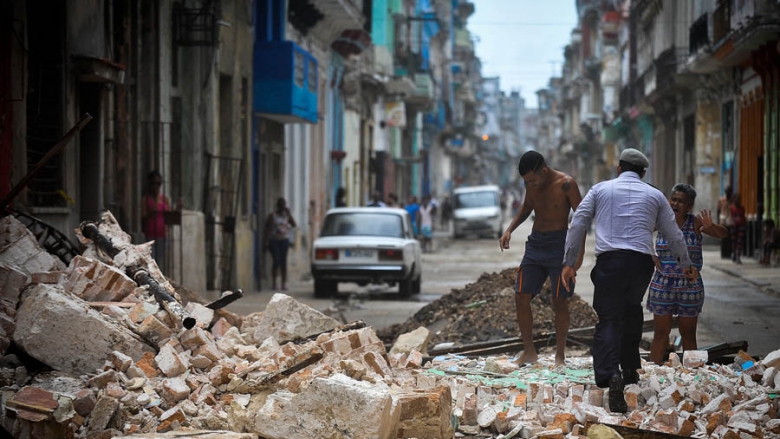
Dimas Castellanos, 13 October 2017 — According to information from the National Defense Council, Hurricane Irma, a category-five storm, hit Cuba between September 7 and 9, causing 14,657 houses to collapse, and another 16,646 to partially collapse, thus totaling 31,303 —not to mention the tens of thousands that suffered other kinds of damage.
Between 2002 and 2004, in the Pinar del Río province alone, Hurricanes Isidore, Lili, Charley and Ivan – categories one, two, three and five, respectively – damaged more than 98,000 properties. In 2008 the tropical storms Fay, Hanna, Gustav and Ike totally demolished around half a million houses; and in 2005, Hurricane Dennis, a category-three storm, damaged more than 80.000 homes in Pilón (Granma), more than 70% of the homes in Casilda (Trinidad), 5,241 homes in Santiago de Cuba, more than 25,000 in Granma, some 400 in Jaruco (Mayabeque), more than 3,200 in Matanzas, 8,200 in Sancti Spíritus, and 1,828 homes in the capital.
The magnitude of this damage was such that the sum of the houses damaged by cyclones alone is similar to the figure for the housing shortage that the Revolution inherited: according to the Economic Commission for Latin America and the Caribbean, the housing deficit until 1959 was of about 700,000 homes, while the pace of construction between 1946 and 1953, according Erich Trefftz, was 26,827 as an annual average, a figure that increased between 1953 and 1958.
In 1953 Fidel Castro proposed “A revolutionary government would solve the housing problem by resolutely lowering rents by 50%, sparing from any contribution those homes inhabited by their own owners, tripling taxes on rented houses, demolishing the infernal barracks and erecting in their place modern high-rises, and financing the construction of houses throughout the island on a scale never seen before, based on the idea that it is ideal, in the countryside, for each family to owns its own land, and, in the city, for each family to live in its own house or apartment.”
On October 14, 1960, in its Urban Reform Law the revolutionary government established that: “Every family has a right to decent housing, and the State will ensure this right in three stages; in the medium term, the State will build, with its own resources, homes that it will cede in permanent usufruct, free, to each family.”
The final provision of said Law stated: “Exercising the Constituent Power wielded by the Council of Ministers, this Act is declared an integral part of the Basic Law of the Republic. Consequently, this law is granted constitutional force and hierarchy.”
However, as an annual average, the first plan, from 1960 to 1970, was unable to exceed 11,000 homes; and the second plan, from 1971 to 1980, barely reached 17,000. Thus, in the first 20 years the pace of annual construction was lower than that of the period from 1946 to 1953. Thus, instead of relieving the housing shortage, it was aggravated.
To recover from the setback, it was proposed to build 100.000 per year starting in 1981, but in the first decade it was unable to exceed 40,000 per year. This plan was interrupted in 1995 by the crisis known as the “Special Period”. Carlos Lage Dávila, secretary of the Executive Committee of the Council of Ministers, then presented a report to the National Assembly of the People’s Power in 2005, in which he assured that due to the “improvement of the country’s financial potential,” they were going to “construct and finish no less than 100.000 new houses per year as of 2006.” That is, a second plan of 100,000 homes would be undertaken.
According to the National Bureau of Statistics, in 2008 about 45,000 were built, but in the year 2013 there were fewer than 26,000 (a figure again below the average for the period from 1946 to 1953, when the population of Cuba was half today’s). That is, in five years construction decreased by about 19.000 houses.
A conservative estimate of the non-fulfillment of the plans, and houses destroyed by atmospheric phenomena, yields a shortage greater than the 700.000 that were calculated before 1959. And this figure would be even worse if it were not for the more than two million Cubans who have left the country since 1959.
If we accept the fact that the figure remains at 700,000, at the rate of about 25,000 per year, it will take 28 years just to make up for the shortage. If we also account for Cuba’s new needs, due to demographic growth, the ageing of existing housing, the lack of maintenance, the increasing number of collapses, the shortage of construction materials, and the effects of natural phenomena … it will take about half a century. We are, then, dealing with a major housing crisis and all its implications.
The Urban Reform Act of 1960 stated that “The State, with its own resources, will build the homes, which it will give in usufruct, permanently and free, to each family.” Then the General Housing Law of 1984 defined the “microbrigade” as the main instrument for their construction. Meanwhile, the failed plan for 100,000 placed the responsibility on families, a demonstration of the incapacity of the State to tackle the housing issue alone.
An abridged account of the 50 years that separate us from the Urban Reform Law of 1960 reveals a shift, spanning from the State’s promise to build and to grant decent housing, permanently and for free, to the construction of houses with palm trees toppled by the hurricanes, with roofs of zinc tiles or asbestos cement, likely to be demolished by future hurricanes. But it also reveals the impossibility and inability of the totalitarian state to solve the housing crisis, as this would require joint action by Cubans, equipped with basic instruments, such as the rights and liberties of citizens, to contribute to the resolution of a problem as vital as housing, one of the basic components of integral human development.
Translation from DiariodeCuba.com
